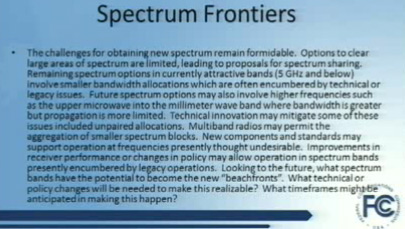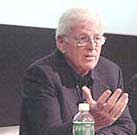TAC on Spectrum Frontiers: Where Does Innovation Come From?
Visual from 3/11/13 FCC TAC meeting
On Mach 11, 2013 the FCC’s Technology Advisory Council held its first meeting of the year. In stark contrast to previous FCC chairmen, Chairman Genachowski opened the meeting and seemed to enjoy being with this group. (I recall when the Disney CTO resigned from TAC a decade or so ago because of his perception that there was no interest in its advice from the 8th Floor and his observation that in a parallel group at SEC that agency’s chairman regularly met with the advisory committee.)
Part of the deliberations dealt with “Spectrum Frontiers” and the slide projected for that discussion is shown at the top of this post. It correctly says that future systems may move into the millimeter wave (mmW) band (frequencies above 60 GHz) and that technical innovations may make use of such higher frequencies more practical.
If you were to ask a prominent communications attorney to do due diligence on a business plan involving technology above 95 GHz I suspect he would report back to potential investors that there would be a 3-4 year delay for new service rules based on recent FCC performance in Title III regulation - think UWB, BPL, AWS-3, TVWhitespace, LightSquared, etc. Would anyone in their right mind invest in technology subject to such regulatory uncertainty?
FCC Chairman Charles Ferris (1977-81)

In order to get the investment needed for practical technology in these bands, FCC must give assurance to developers and investors that any deliberations will be both transparent and timely. Comm. Pai has rediscovered the long lost Section 7 of the Communications Act. (It wasn’t really lost, just ignored by FCC for almost 30 years on a bipartisan basis.) Rather than have the TAC deliberate on how this now idle spectrum might be used - perhaps with Soviet-style planning, let’s have faith in the marketplace and encourage capital formation for technology development >95 GHz by giving assurances of timely consideration of any new service rules.
Why doesn’t FCC just declare that technology >95 GHz is presumed to be “new technologies and services to the public” and thus subject to the terms of Section 7. As I read Section 7(a) it would apply to both FCC and NTIA - important since all bands >95 GHz are shared and thus subject to NTIA coordination. (Section 7(b) clearly only applies to FCC.)




![Validate my RSS feed [Valid RSS]](valid-rss-rogers.png)

